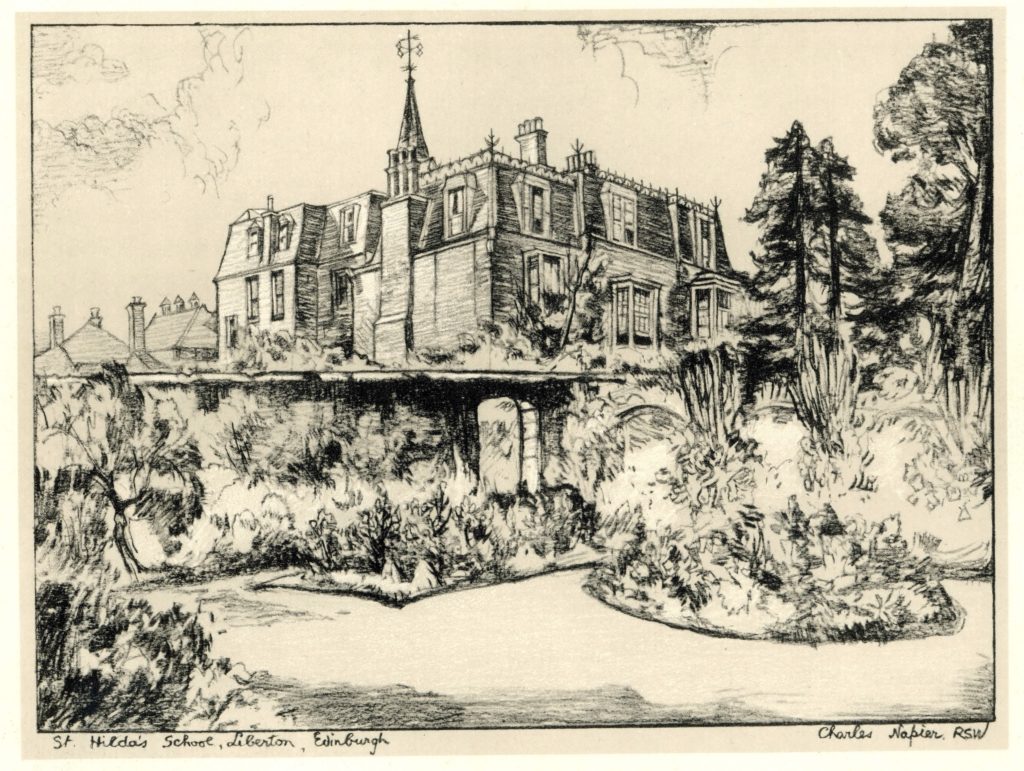

‘St Hildas’ (the name it was given in 1901) started as a substantial two storey house built in 1837 by William Whyte, a book and music seller, who had earlier commissioned Haydn to set Scottish songs, recently recorded by Brilliant Classics. He modestly called the house ‘Kirkbrae Cottage’. Whyte was a lifelong bachelor and his 100 page will shows that he was thoughtful and generous- and a shrewd businessman. He wouldn’t have been worried that a Scottish gent whose similar request Haydn had shelved meantime called him ‘an obscure music-seller’ (he wasn’t) but he might have been concerned if he had known that Hadyn gave some of the work to his pupils. Whyte kept a horse and brougham, probably mainly to go to Lady Glenorchy’s Church in Greenside, where he was an elder. He died in 1858 and is buried in Old Calton Graveyard.
In 1858 the house was bought by a stationer, George Murray, who died in 1867. Next it was occupied and extended by Dr David Brodie, a medical graduate of St Andrews and his wife. They added the third storey at the north end and the front rooms, which are separated from the rest by a former outside wall.
Brodie became the first Physician Superintendent of the new Institution for Juvenile Imbeciles at Larbert in 1863, having previously been running the Edinburgh Idiot Asylum in Gayfield Square as a profit making concern. His wife played a major part in fundraising for the Larbert Institution and it is not clear why he didn’t remain there (possibly because of his wife’s health- she died of TB shortly after they moved here). Brodie began to have a financial and structural interest in the house from 1867, paying a final instalment in 1876. He set it up as an ‘institution for juvenile imbeciles of the upper classes’ and renamed it Columbia Lodge. He, his helpers and his charges appear in the 1871 and 1881 censuses.
The house was next bought in 1882 by C(K)atherine Jockel, who first appears in Glasgow in 1841 census as the wife of a sausage maker (both were immigrants from Germany). Her husband’s brother, who lived with them in Glasgow, set up as a butcher in Edinburgh’s Queen Street and went spectacularly bankrupt twice. Mrs Jockel was a lot more successful in her business – a dress and embroidery shop in George Street which prospered through the Victorian craze for embroidery and her ability – she was definitely the brains of the family and must have been a formidable woman.
Before she came to the house she lived in a posh house (Gogarmount) in Ratho, now part of the RBS complex, where she had an embroidery workshop. She probably planted the monkeypuzzle and other tall trees – there are such at Gogarmount. She renamed the house Kirkbrae House ( a name later assumed by the property in Lasswade Road now occupied by Margiotta). Mrs Jockel had a daughter, Louisa Stoltz, who also lived here after she was widowed, as did the daughter’s daughter, Rosina Stoltz. Mrs Jockel died in 1899; she and her husband ( who died much earlier) are buried in the Dean cemetery.
Rosa went to George Watsons Ladies College and graduated from Edinburgh in 1898 with a third class honours degree in Classics, an early woman graduate. She and her mother started St Hilda’s school in 1901, supported by their own enthusiasm and the goodwill of some eminent folk. They built the rear wing and staircase as accommodation for the pupils and gradually acquired Springwood Park and other adjacent buildings. When the school moved away during the 2nd world war, the various buildings were used by the forces (airforce?) but the name remained. Perhaps it is not surprising that we have never had any visits from the folk billeted here, as we have had from former pupils.
After the war St Hildas was split into flats by a builder as it remains now. Some of the room divisions are rather quaint, with breeze block walls resting on floor boards.
Peter Schwarz
December 2013